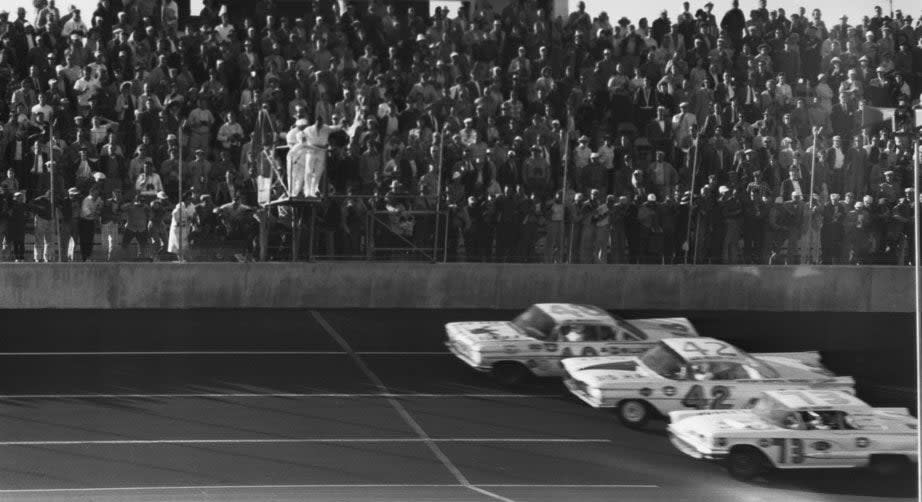Inside photo-finish technology, its evolution and how it decided the Kansas winner
Listen to the NASCAR officials’ radio-scanner channel for any great length of time, and you’re likely to hear the phrase, “per the camera.” It’s a callout from one official to another, confirming with a high-speed camera’s image the outcome of narrow margins that are too close to call by trusting the naked eye.
In some instances, that prompt is followed by the correct order of car numbers to determine the race off pit road. Other times, it’s to give proper credit to a lap leader during a green-flag run. Sunday’s “per the camera” moment was for all the Kansas checkered-flag marbles.
The oh-so-slim margin at the end of Sunday’s NASCAR Cup Series race at Kansas Speedway relied on a high-speed camera to determine that Kyle Larson had beaten Chris Buescher to the start/finish line by 0.001 seconds. The margin was the closest in the series’ history.
The same technology was used just one day earlier to decide horse racing’s crown jewel, the 150th Kentucky Derby, won by a nose by Mystik Dan. There, the winning speed was far slower — a lap average at 36.485 mph this year on the 1.25-mile Churchill Downs course — but the technical details used to capture what could be missed in a blink is no less complex.
RELATED: Closest finishes in Cup history | Larson lunges to Kansas victory
NASCAR uses a line-scan photo-finish camera and software system called FinishLynx, made by Massachusetts-based Lynx System Developers. FinishLynx has applications in a variety of motorsports series, including IndyCar, Formula 1 and MotoGP, and has also been used in cycling’s Tour de France and in track and field events.
The image from Sunday’s Cup Series finish showing Larson’s No. 5 Chevrolet just ahead of Buescher’s No. 17 Ford is a composite of thousands of tiny, vertical image slices from the start/finish line. When cars cross the line, the camera captures several thousands of precise, timestamped images per second to create the photo-finish result image. The camera is always on; the image-capture process is activated by the first sign of motion at the finish-line focus point — in this instance, the appearance of Larson’s front splitter breaking the plane to complete the final lap.
That composite image was made available shortly after the checkered flag to the NASCAR control tower, where race officials made the final ruling — per the camera. The finish was so close that timing and scoring data initially showed Buescher ahead because it fell within the transponders’ margin of error — a razor-thin 1.5 milliseconds.
The camera — which is set up each week in an empty, barricaded pit stall and aimed at the start/finish line on the frontstretch — is calibrated at least once daily during a race weekend. A separate camera is trained on the pit-road exit, and data from both is fed through the FinishLynx software, which has a primary and a backup. The semi-grainy feel to Sunday’s image quality, officials explained, was due to the nighttime finish and the longer distance from the camera’s location to the start/finish line across Kansas’ large patch of tri-oval infield grass. A daytime finish at, for instance, Martinsville Speedway — where the line is much closer to pit road — would be far clearer.
That focal point at the leading edge of the start/finish line cuts through any imperfections in the on-track line painting — which isn’t laser-measured by the grounds crew, and can include checkered-flag designs, track names and/or sponsor logos depending on the event. The physical start/finish line can also be altered by fans writing messages in that area during pre-race track access and the wear and tear of Goodyear rubber from a full field of stock cars crossing it hundreds of times. The camera’s line is the final judge.
WATCH: Larson wins by an eyelash in Kansas
The level of precision and speed of photo-finish technology wasn’t always the norm. The first Daytona 500 in 1959 wasn’t decided until days after the finish, when photographer T. Taylor Warren‘s single frame reversed the initial scoring decision, handing the victory to Lee Petty over Johnny Beauchamp.

Nearly 15 years later and back at Daytona, the only instance of a dead heat in Cup Series history took place in the contest for third place in the 1974 Firecracker 400. A more primitive high-speed camera system — 300 frames per second — was in place for the photo finish, which featured Buddy Baker’s No. 15 Ford racing door-to-door with Cale Yarborough’s No. 11 Chevrolet.
In an account reported by Gary Long for the July 6 edition of the Miami Herald, the images took nearly 40 minutes to develop in the darkroom, but the small negatives that came out were inconclusive. Prints would be necessary, meaning another 30-minute wait that Baker and Yarborough spent trading good-natured barbs.
After a half-hour, along comes NASCAR President Bill France Jr. with a pile of photos. “Who got it?” he was asked. France replied with a laugh, “We can’t figure that out yet. It’s that close.”
They never did. The finish was ruled a tie, and officials pooled the third- and fourth-place prize money to split evenly — after an adjustment for contingency bonus awards — between Baker and Yarborough.
If such a deadlock happened in current-day NASCAR, even with more modern technology in the competition department’s hands, a tiebreaker system is in place to determine the finish. In the event of a dead heat, the higher finishing position is awarded to the driver who leads more laps. If that category does not settle the tie, the driver with the most laps spent in second place earns the tiebreak (then third place, fourth, and so on until the tie is broken).

